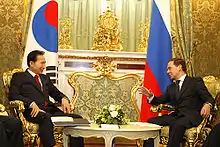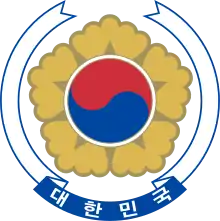Russia–South Korea relations
Russia–South Korea relations (Russian: Российско-южнокорейские отношения, Rossiisko-yuzhnokoreiskie otnosheniya, Korean: 한러 관계, hanreo gwangye) or Russian–South Korean relations refers to the bilateral foreign relations between Russia and South Korea. Modern relations between the two countries began on September 30, 1990.
 | |
Russia |
South Korea |
|---|---|

Immediately following Japan's 1910-1945 colonial rule of Korea, the Cold War between the Soviet Union and the United States created the division of Korea into North and South states. Thereafter, since the two sides were separated by North Korea and opposing ideologies, there was little contact until the fall of the Soviet Union.
Since the 1990s, there has been greater trade and cooperation between the two nations. The total trade volume between South Korea and Russia in 2003 was 4.2 billion US dollars,[1] which increased to 24.8 billion US dollars in 2018.[2]
History
Russian Empire
The Russian Empire and Korea first established formal diplomatic relations in 1884, after which Russia exerted considerable political influence in Korea.[3] In particular, in 1896, the Korean royal family took refuge from pro-Japanese factions in Seoul at the Russian diplomatic compound. After the defeat of Russia in the Russo-Japanese War, however, Russian influence in Korea fell to near zero.
Soviet Union
.png.webp) | |
South Korea |
Soviet Union |
|---|---|
Before 1970, relations between the two countries were generally hostile, due to the Soviet Union supporting China and North Korea during the Korean War. The United States maintained military bases and nuclear weapons in South Korea, which the Soviet Union viewed as a threat to its security.
South Korea had been seeking to trade with the Soviet Union even before Gorbachev came to power. Gorbachev desired foreign capital and high technology, as well as Seoul's help in alleviating the Soviet economic crisis through direct investment, joint ventures, and trade. As early as May 1979, South Korea signed an agreement obtaining Finnish assistance in exporting to the Soviet Union and Eastern Europe.[4]
In the 1980s, South Korean President Roh Tae-woo's Nordpolitik and Mikhail Gorbachev's "New Thinking" were both attempts to reverse their nations' recent histories. Gorbachev had signaled Soviet interest in improving relations with all countries in the Asia-Pacific region, including South Korea, as explained in his July 1986 Vladivostok and August 1988 Krasnoyarsk speeches.[4]
The natural resources Seoul increasingly needed—oil, metals, timber, and fish—are abundant in the Soviet Far East. Trade with the Soviet Union, Eastern Europe, and China would also alleviate South Korea's apprehension over the United States' increasing trade protectionism. South Korea's expanding trade with Eastern Europe and the Soviet Union initially was encouraged by the United States, although Washington later became increasingly concerned over possible high-technology transfers.[4]
Improved Seoul-Moscow relations were planned in three related stages: sports, trade, and political relations. The 1988 Seoul Olympics was a major catalyst. Moscow sent more than 6,000 Soviets to South Korea and Soviet tourist ships came to Busan and Incheon and Aeroflot planes landed in Seoul.[4]
On November 10, 1988, the Soviet Politburo, for the first time, reconsidered its relationship with South Korea. Because of the lack of diplomatic relations, most South Korean-Soviet trade initially was indirect; Eastern Europe, Hong Kong, Japan, and Singapore served as intermediaries. With an increasing volume of trade, Seoul and Moscow began trading directly, using facilities near Vladivostok and Busan. The Korean Trade Promotion Corporation (KOTRA) and the Soviet Chamber of Commerce and Industry exchanged a trade memorandum in 1988 pledging mutual assistance in establishing trade offices in 1989. Seoul's trade office in Moscow opened in July 1989; Moscow's trade office in Seoul opened in April 1989. Several major South Korean businesses including Daewoo, Sunkyong, and Lucky-Goldstar traded directly with the Soviet Union in 1990.[4]
South Korea's new-found wealth and technological prowess had been attracting the interest of a growing number of socialist nations. In initiating Nordpolitik, Roh's confidential foreign policy adviser was rumored to have visited Moscow to consult with Soviet policymakers. Kim Young Sam visited Moscow from June 2 to June 10, 1989, as the Kremlin announced that it would allow some 300,000 Soviet-Koreans who had been on the Soviet island of Sahkalin since the end of World War II to return permanently to South Korea. Moscow even arranged Kim's meeting with the North Korean ambassador to the Soviet Union.[4]
In June 1990, Roh held his first summit with President Gorbachev in San Francisco.[4]
Russian Federation

After the collapse of the Soviet Union, South Korea and Russia established diplomatic ties in 1991. On November 20, 1992 Russia and South Korea signed a protocol providing for regular visits of defence officials and naval vessels between the two countries.[5]
On July 23, 1997, during a visit of the then Russian Foreign Minister Yevgeny Primakov to Seoul, a ‘hot line’ agreement was signed providing for the establishment of a special communications link between the official residences of the Russian and South Korean presidents.[6]
Russian president Vladimir Putin visited Seoul in February 2001, while South Korean president Roh Muhyeon visited Moscow in September 2004.[7][8]
South Korea and Russia are participants in the Six-party talks on the North Korea's nuclear proliferation issue.
In November 2013, Russia and South Korea signed a visa-free travel regime agreement.[9]
_18.jpg.webp)
From 21 to 23 June 2018, South Korean president Moon Jae-in paid a state visit to Russia. On June 21, he addressed the State Duma, the lower house of the Russian Federal Assembly. He became the first South Korean leader to speak in the Russian Parliament.[10] On June 22, Russian President Vladimir Putin held talks with Moon Jae-in in Moscow. Leaders signed a document for foundation of free trade area.[11]
On 28 August 2018 Vice Defense Minister Suh Choo-suk met with Russian counterpart Alexander Fomin and reached an agreement to install a direct communication line between their air forces of two countries.[12]
Economic cooperation
South Korea and Russia are working together on construction of a bilateral industrial complex in the Nakhodka Free Economic Area in Russia's Far East and gas-fields development in Irkutsk. The two sides also agreed to cooperate on reconnecting a planned inter-Korean railroad with the Trans-Siberian Railway. Russia has expressed interest in becoming a conduit for South Korean exports to Europe, which now go by ship, by linking the Korean railroad to the TSR.[13][14]
Russia reportedly offered to repay its $1.7 billion debt to South Korea through joint investments in North Korea, such as the railroad project.[15]
Space program
South Korea sent its first cosmonaut on board a Soyuz flight to the International Space Station in April 2008. South Korea made domestic satellite launches in 2009 and 2010, both with Russian assistance. The first South Korean satellite was successfully launched in 2013 with extensive Russian assistance and a Russian first stage.
North Korean nuclear threat
After the nuclear test on May 25, 2009 for which North Korea was facing much censure from many countries, Pyongyang has threatened to attack South Korea after it joined a U.S.-led plan to check vessels suspected of carrying equipment for weapons of mass destruction. Many news agencies in Moscow were fearing that this move may lead to nuclear war. North Korea also threatened many other countries such as the US and other federations across the world. A few days later, South Korean President Lee Myung-bak and Russian President Dmitry Medvedev agreed in a phone call that a strong international response was needed, including U.N. action, Lee's office said. Russia said that it will work with Seoul on a new U.N. Security Council resolution and to revive international talks on the North Korean nuclear issue.
Human migration
Koryo-saram is the name which ethnic Koreans in the Post-Soviet states use to refer to themselves. Approximately 500,000 ethnic Koreans reside in the former USSR, primarily in the newly independent states of Central Asia. There are also large Korean communities in southern Russia (around Volgograd), the Caucasus, and southern Ukraine. These communities can be traced back to the Koreans who were living in the Russian Far East during the late 19th century.[16] There is also a separate ethnic Korean community on the island of Sakhalin, typically referred to as Sakhalin Koreans. Some may identify as Koryo-saram, but many do not. Unlike the communities on the Russian mainland, which consist mostly of immigrants from the late 19th and early 20th centuries, the ancestors of the Sakhalin Koreans came as immigrants from Gyeongsang and Jeolla provinces in the late 1930s and early 1940s, forced into service by the Japanese government to work in coal mines in order to fill labour shortages caused by World War II.[17]
Russians in Korea began arriving as early as 1885; however, virtually all of the current Russian community in South Korea, estimated at about 10,000 people, is composed of recent migrants.[18]
Cultural exchange
There have been cases of cultural exchange between the two countries before the official diplomatic recognition. The introduction of Korean literature to the Russophone area was relatively active until the 1970s mainly through Korean classical stories.[19]
References
- "Russia ends WTO talks with S. Korea". People's Daily. 2004-09-22. Retrieved 2007-05-28.
- "Economic Relations between Russia and South Korea in the New Northern Policy" By Liudmila Zakharova. Korea Economic Institute of America. Page 3.
- A. Torkunov, V. Denisov, Россия - Корея: взгляд из прошлого в настоящее Archived 2016-04-02 at the Wayback Machine (Russia – Korea: a view from the past into the present)
- "Relations with the Soviet Union". Library of Congress Country Studies: South Korea. Library of Congress. June 1990. Retrieved 2007-05-28.
- Chronology of principal defenceand security-related agreements and initiatives involving the Russian Federation and Asian countries, 1992–99
- Chronology of principal defence and security-related agreements and initiatives involving the Russian Federation and Asian countries, 1992–99
- "Russia makes up lost ground with Korean proposals". Asia Times. 2001-02-27. Retrieved 2007-05-29.
- "South Korean president's visit to boost ties with Russia". People's Daily. 2004-09-24. Retrieved 2007-05-28.
- Russia, S. Korea Sign Visa-Free Agreement
- Президент Республики Корея Мун Чжэ Ин выступил в Государственной Думе
- South Korean President Moon Jae-in in Russia to Boost Economic Ties
- S. Korea, Russia to Install Direct Air force Communication Line, kbs.co.kr, 2018-08-30
- "Putin pledges support for reconciliation on Korean Peninsula". Kyodo. 2001-02-27. Archived from the original on 2008-06-12. Retrieved 2007-05-29.
- "Russia, South Korea close to Railroad Agreement". MosNews. 2006-02-27. Retrieved 2007-05-27.
- Blagov, Sergei (2006-09-11). "Russia, China, Japan, and South Korea to launch new sea route linking China and Japan". Eurasia Daily Monitor. 3 (166). Archived from the original ( – Scholar search) on November 21, 2006. Retrieved 2007-05-29.
- Lee Kwang-kyu (2000). Overseas Koreans. Seoul: Jimoondang. pp. 7–15. ISBN 89-88095-18-9.
- Ban, Byung-yool (2004-09-22). "Koreans in Russia: Historical Perspective". Korea Times. Archived from the original on 2005-03-18. Retrieved 2006-11-20.
- "A taste of Russia in heart of Seoul". JoongAng Daily. 2004-11-08. Archived from the original on December 10, 2004. Retrieved 2007-05-28.
- Kwak (곽), Hyo-hwan (효환). "러시아어권으로 소개된 한국문학- 70년대까지 고전중심으로 활발히 소개, 80년대부터 급감". Daesan Munhwa (대산문화). Retrieved 2011-09-20.

